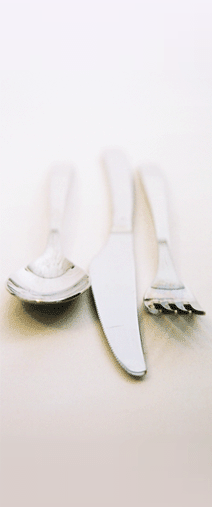My White Chocolate and Baileys Tart
January 15, 2007
11:33 AM
In the year 2000 Baileys produced a cookbook called
Pure Indulgence.
This was
“Delicious food and drink recipes using Baileys from prizewinning
Irish restaurants and bars”
I was one of the restaurants asked to contribute and as I had a recipe which was a bit of a signature in my restaurant and which used Baileys this was an easy pick for me.
Baileys organised everything, photo shoots, testing of recipes and all the lovely glossy production.
The book is now out of print but I sold a lot of copies in the restaurant when it was about.
For some reason my contribution seem to grab peoples imaginations and was frequently the one reproduced in reviews.
I remember Googling it in at one stage and finding it in a lot of restaurant menus, even in a couple in Australia.
Of course it became a standard in the my restaurant and by the time we shut in 2004 I was heartily sick of it.
I made my first one in over four years last week and discovered that time has been kind to the recipe.
I enjoyed the result.
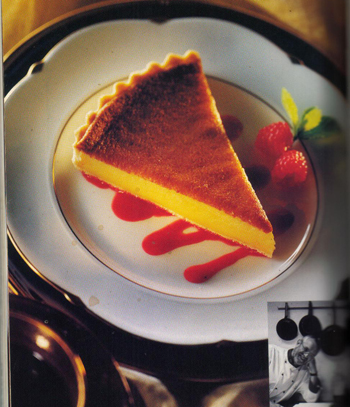
This is the picture that appeared in the Pure Indulgence book.
This time I tweaked it a little.
I used the new Caramel Baileys instead of the original
and I used Green and Black’s White Chocolate with Vanilla
which is an extremely good white chololate, even if very expensive.
It did turn out extremely well.
White Chocolate Tart with Baileys
Filling;
350g(12oz.) White Chocolate
1 Lge measure of Bailys (or two)
175g(6 oz.) Unsalted Butter
4 Eggs and 4 Egg Yolks
2 Tbs Honey
Pastry;
225g(8 oz.) Flour
30g(1 oz.) Castor sugar
110g (4 oz.) Butter
1 Egg Yolk
2 Tbs. Water
Set oven to 180C 350F Gas 4
You will need a 12ins. x 1ins. deep Tart Tin
Method;
For the pastry, dice the butter and rub it in to the flour and sugar. Add the egg and water and bind into a dough.
(or make in a food processor in the usual way)
Roll out to line the tart tin leaving a small overlap in case it shrinks.Line with non-stick paper and weights and bake blind for 15 mts.Remove the paper, paint with eggwash and bake for a further 5 mts to brown and crispen.
Filling; Melt the chocolate gently with the butter.
You can do this in a microwave or in a bowl over a pan of simmering water.
Stir in the Baileys and leave to cool a little.
Beat the eggs, egg yolks, and honey together until thick and white.
At this stage you may need to re-whisk the chocolate mixture.
If it has separated stir in a few spoons of the egg mixture to bring it back
Fold both mixtures together and pour into the pastry shell.
Bake for 30 mts or until just set.
It should rise a little in the cooking and then sink again.
It looks well to sieve some icing sugar on the top before serving.
This gives 10 to 12 good slices.
Napoleon, I Owe You
January 14, 2007
22:50 PM

The young Napoleon
My son-in-law, Aonghus, once kindly said something to me that particularly pleased me.
He said “ Martin, the thing about you is that you have interests”
Of course my family would have corrected him and told him that what I am is obsessive, I get an interest in something and don’t rest until I have gotten all the information I want about it.
There have been times when this compulsion has paid off in spades.
My teenage obsession on Napoleon Bonaparte is a case in point.
It all started with my banning from reading all books for a year (see previous words)
As soon as I started to read again I started to read with a savage avidity.
I started with all the books I could find in the house.
Neither of my parents were wide readers but both, in those pre- television days would always have a novel on the go.
The house was full of Nevil Shutes, Ian Flemings,and for my mother Georgette Heyers and , her personal favourites, the romantic Irish novels of Maurice Walsh.
I read my way through all these and many more.
I even read my way through the books my father kept underneath his clean shirts in his large mahogany chest of drawers.
I enjoyed then all equally, even the Heyers, these giving me a taste for historical novels which I still have.
I struck pay dirt though when I started to read a book by Annamarie Selinko, called Desireé.
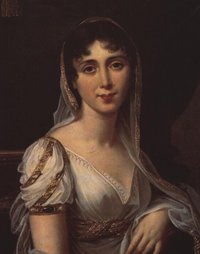
Queen Desireé of Sweden
This was a novelisation of the truly fascinating Desireé Clary, a daughter of an old Irish family of silk merchants in Marseille.
She was one time flame of Napoleon, her sister Julie married his brother Joseph, she was to marry one of his generals; Bernadotte who, in turn was offered, and accepted the Swedish throne and so she became the mother of the modern royal family of Sweden.
Not bad for a descendant of the Clearys from Wexford!
Is it any wonder (I can feel my curiosity rising once more) that I decided I wanted to find out as much as I could about her, and not just her (there was very little information about Desireé that I could find) but about her old flame, his family and the entire shanigans of the Bonaparte family.
There was loads available about them.
I found a sympathetic librarian in Cork Library who was only delighted to order books about Napoleon for me. I got the titles from the simple expedient of looking up the books referenced in the books I was reading and ordering in the ones I thought I would find interesting.
This way I became quite knowledgeable about him and all his family, his rise, his reign as Emperor and his decline, defeat and exiles.
After about a year the interest died down but remained in there on the back boiler in my mind.
It was to resurface when I was sitting my finals for my BA in history in UCD about seven years later.
I was not an ideal student, in fact my student career would best be glossed over.
However in preparation for my History finals I decided to have I go through past papers and discovered that if I was lucky and careful I could answer all the European section on Napoleon and his wars.
I was lucky.
The right stuff came up and I got my degree in history based on the work I had put in in the library in Cork when I was 14.
Sometimes it’s great to have interests!
1 comment.
My Myopia
January 14, 2007
16:35 PM
I was born a myope, that is someone suffering from myopia or as this is more commonly called,short-sightedness.
This condition is exactly that, an ability to read and to see things perfectly at close range, the problem starts (for me anyway) at about three feet from my eyes and gets successively worse after that.
I am being precise about this because I lived through the aggravation all through my life of people saying to me “You don’t need glasses at all, I’ve seen you take them off to read” as if their continued presence on my nose was a sort of fashion statement.
Because we cannot see as others see we don’t know that we are short-sighted when we are young.
My problems started when I started to get the bus home from school.
I couldn’t read the number and often ended getting on the wrong one and ending up at the wrong destination.
My mother was endlessly sympathetic of this and used to organise someone to meet me after school and put me on the correct route home.
I think they assumed that I was just particularly stupid.
My older brother David, who is four years older than me, was diagnosed as myopic when he was twelve and got a pair of glasses.
On a day which is forever engraved in my memory I was standing in the upstairs nursery of our house in Cork.
I tried on my brothers new glasses and then looked out the window at the grass below.
To my amazement the green blur suddenly became a precise lawn of grass. To my amazement I could make out each individual blade, and from upstairs! To get that sharpness of vision previously I would have to be down on all fours!
So, I was duly tested , found wanting, and got my own glasses.
Life changed immediately for the better after that, buses were catchable,
the blackboard was visible, people were recognisable at further than three paces.

Portrait of the writer as a young myope
The trouble was that as soon as I was diagnosed my myopia began to accelerate rapidly and by two years my glasses had become quite strong.
The specialist decided on a dramatic course of action to arrest this.
He decided that I was to rest my eyes for a year.
I was at this stage twelve years old and in my final year in primary school. This was considered an important year as there were two big exams at the end of the year, the Primary which was a state recognised qualification and at that time a basic one for all jobs, and the secondary school entrance exam.
For this entire year I was to attend school but was forbidden to read or write, to watch television or films or to strain my eyes in any way.
This meant no homework in school and consequently no punishment unless I misbehaved.
I was of course the envy of my classmates.
It had its downside too.
The no television didn’t matter a whit, we hadn’t even a set, the no films wasn’t much of a blow but the no books was a bit of a disaster.
I was a total bookworm and without books used to prowl fretfully about the house complaining about being bored.
My mother tried to teach me to knit, a disaster. I would start off with ten stitches and end up with fifty, or six.
All was resolved when I discovered the radio.
I remember particularly falling in love with the Archers which I used to listen to each day and then to the omnibus addition on Sunday morning.
The year passed very pleasantly.
For some strange reason the staff teacher decided that since I was having troubles I could be excused compulsary games so for a blissful year I was spared the horrors of school rugby.
Because I was not doing any reading I used to listen attentively in class and actually found the whole busisness of reading writing and arithmetic interesting.
In fact the most interesting thing to emerge from that year of forced idleness is that up to this year I had been an indifferent student, sitting somewhere near the middle of the class in grading.
After my year of no reading I sat the Primary certificate along with eighty others in my year and to the astonishment of all, including myself, got the highest marks in the whole school.
I remember being given I special certificate at a general assembly in the school hall the following year.
It begs a question doesn’t it about the benefits of homework.
I have worn glasses happily since that day, nowadays I also have glasses for reading and my normal lenses are varifocal to compensate for my old eyes being both short and long sighted.
Not for me the temptation of fixing the problem with laser surgery.
I have got so used to the glasses now that as would as soon do without my nose as do without them.
Italian Food Art
January 13, 2007
08:42 AM
Both these pictures are taken from Elizabeth David’s 1987
illustrated edition of Italian Food.
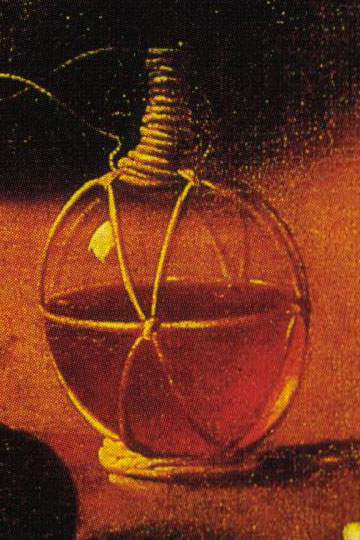
Detail from;
The Fishmonger (17th Century)
School of Saraceni
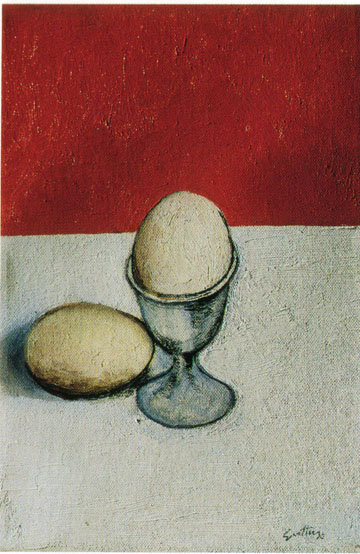
Two Eggs (1980)
Renato Guttoso
Lebanese Salad
January 13, 2007
07:19 AM
When I worked in Snaffles in Dublin in the early seventies I worked with three waiters who were true professionals.
John, Danny and Hugh had all worked in the legendary Red Bank in Westmorland Street and as that had folded at the same time as Snaffles opened they had been scooped up gratefully by Snaffles.
They had been in the business for many years by the time I met them and offered the kind of service which is now long gone.
Ben Kiley tells a story of arriving into The Red Bank having been on a bender and looking very much the worse for wear.
John whooshed him into the gents with instructions to wait till he came back.
He arrived back with a razor and a new shirt for Ben and stood over him until he made himself presentable.
These waiters had worked together for so long that the three of them communicated in a sort of code which one had to crack to be able to communicate. Some of this was the catering equivalent of Cockney rhyming slang, rosy lee for tea, Johnny for boss (from Johnny Ross/Boss; don’t ask me why) Peggy (from Peggy Dell) for a smell.
More of it was puns on the names of the dishes which were on the menu.
One of our signature dishes there at the time was a Lebanese Salad.
This was a tomato and chilli salad served with a yoghurt dressing.
Of course this was never called by that name when being ordered by our waiters, and of course we all understood what they wanted.
Flash forward then to the late Nineties, about twenty five years later.
At this stage I was well established in my restaurant in Waterford and doing my regular cookery piece on the local radio, WLR.
One Tuesday I was doing a piece about salads and decided to give the old Snaffles favourite an airing.
Having done the other recipes, and you must remember that this was going out live on air, Billy the presenter asked me what the next one was to be.
From nowhere the old Snaffles nick name came and insinuated itself around my tongue.
“My next recipe” I said, “Is a delicious combination of tomato, yoghurt and chilli,
It is called Lesbian Salad.”
Lebanese Salad (for 4)
12 med Vine Tomatoes
1Fresh Red Chilli
1 Tbs. Honey
2 Cloves Garlic (finely chopped)
1 250grm. Greek Yoghurt
Freshly Ground Black Pepper
1 tbs. chopped Fresh Chives
Put a shallow cross on the top of the Tomatoes and pour boiling water over them. Immediately plunge them in cold water and then remove the skins.
Cut each one in 4 and discard the seeds.
Chop the Chilli finely and combine that with the yoghurt, honey, crushed garlic and black pepper.
Put the quartered tomatoes in a bowl and spoon over the yoghurt dressing.
Leave these to marinade together for an hour or two before serving.
Serve in individual bowls with the chopped chives scattered on top and with hot pitta bread.
My Coleslaw Block
January 12, 2007
14:51 PM
Every year around Christmas our book club has a different sort of meeting.
Instead of books we have to have ready a favourite poem to recite
and we also make a meal of it, in that everyone brings a dish to
contribute to what amounts to our Christmas party.
The host house is allowed to decide who brings what.
This year the host is our friend Petra and her request to me was to bring a dish of coleslaw.
I do hope my rapidly sinking heart didn’t show on my face.
Of all the dishes in the world how could she have picked this one!
Coleslaw and I have a history.
In the early eighties a job came up in a small food producers which was making produce for delicatessens in Waterford.
I had, or thought I had had, enough of the antisocial hours of restaurant catering and, as this job was 9 to 5 and weekends off I thought I would give it a go.
As it turned out about 75% of the work went into the production of Coleslaw.
The daily routine consisted principally of shredding cabbage, carrots and onions and then mixing them with a very strong vinegary mayonnaise.
The actual mixing was in a large fibreglass bath both shaped and sized like a domestic bath.
We had discovered that to prolong the shelf life of the salad it was essential to crush the leaves as little as possible, and the best way of insuring this, it turned out, was to mix it by hand.
The mixer, had to kneel by the bath with full length plastic gloves taped to his armpits and mix what must have been about 60kg of coleslaw at a time.
The essential plastic gloves were available in the local chemists and we used to go through quite a few.
There was an amazing week when a Coleslaw factory in England went bust and we were suddenly making the bloody stuff by the ton.
Around that time I spent a lot of time running up and down to the chemist buying these gloves.
On one of these visits the Chemist himself came out from behind the counter and asked me quizzically;
“Do you mind me asking what do you do with these gloves?”
He had a full box in his hand as he asked me and it was only then that I realised what the gloves were intended to be used for.
(Waterford you must remember was at that time surrounded by cattle farms.)
They were vets gloves for artificially inseminating cows.
To my eternal shame I blushed, thereby convincing the Chemist that I was rampaging around the country side getting my sexual thrills using these gloves on comely Frisians.
I was instantly reminded of a line in a Tom Lehar song in which he had talked about a farmer who;
“had practised animal husbandry; until they caught him at it”
I may have tried to stutter an explanation but at that stage it was too late.
Shortly afterwards I decided that evenings and weekends weren’t what they were cracked up to be and went back to working in restaurants.
I hadn’t made Coleslaw since, you can perhaps understand why.
Today I decided it was time to lay the ghost so I took my courage in my hands and my largest spoon and bowl(no more gloves for me) I mixed another batch.
Maybe it was the time lapse (twenty odd years) our maybe it was because I radically modernised the recipe but the resulting Coleslaw is actually quite nice.
So you can see Petra, it is OK.
You have helped me to conquer my Coleslaw Block.
Here is the recipe.
New Coleslaw
½ Head or White Cabbage
¼ Head Celeriac
6 Carrots
2 Onions
4 eating apples
Dressing;
2 Teaspoons seedy mustard
1 teaspoon salt
1 tablespoon Honey
Good grating of Black Pepper
6 Tablespoons White Wine Vinegar
225ml Sunflower Oil
To do this with any ease you need to have a food processor with a slicing blade.
Trim the cabbage and cut in four and discard the core.
Feed the rest through the slicing blade in your processor.
Change the blade to the coarse grater
Peel and slice the celeriac similarly and feed that through this blade.
Peel the carrots, peel and quarter the onions, quarter and core the apples but don’t peel and feed these through the grater also.
Mix these vegetables together.
Mix well together all the ingredients for the dressing except the oil
And then blend this into the other ingredients slowly.
Then dress the salad.
I think this benefits from being made the day before as this helps to soften the cabbage a little.
I also added a few walnuts and some sunflower seeds for posh.
They are not essential but do add to the crunch.
1 comment.
Ardrahan Lullaby
January 11, 2007
22:23 PM
I have been eating Ardrahan Cheese for years (and extrememly good it is too)
but just today I came across a new product they have started to produce.
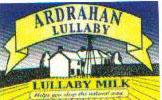
This is Ardrahan Lullaby milk.
According to their blurb, and this I quote directly
“It is created in the dark, while the animal sleeps, and it has naturally higher levels of melatonin.”
“It helps our bodies to regulate our sleep-wake cycles allowing our body clock to switch off naturally”
I have this wonderful picture of the milkmaids tiptoeing into the meadows, their buckets lined with cotton wool, lest their splashing should waken the sleeping cows.
Should it perhaps carry a guarantee;
NO COW HAS BEEN WOKEN FROM SLEEP IN THE MANUFACTURE OF THIS PRODUCT
All the same, if it works…………..
Thèzan-lès-Béziers 2
January 10, 2007
12:45 PM
Last week Sile and I began to get our first taste of what living in France was going to be like.
There were downsides.
As a nation they are perhaps not as efficient as they think they are.
We had already experienced that when the bank were a little tardy in getting a cheque for us.
Yhis time we had an appointment with the water board at 15.30 on Wednesday.
This was made, I was very impressed to note, by email and confirmed by email by me.
When they hadn’t arrived by five Sile rang them.
“But Madame” she was told, “The appointment was for 1.30, M. arrived and there was no-one there”
We had a copy of the email,with the correct time, in our hands.
They however made another appointment for the following day, and this time they arrived only three hours late and, unfortunately, they couldn’t turn on the water anyway, and they would need someone in the house when they did.
Difficult when one is living in Ireland.
However there were good bits too.
The first day we arrived we were just collecting some food in the house when a charming neighbour spotted us and asked us over to her house for an aperitif.
Two other neighbours to whom we introduced ourselves were also very welcoming.
One man who had a marvellous walrus moustache was delighted that we were Irish and instantly made the rugby connection .
I am obviously going to have to learn how to talk fluent French rugby to survive.
We were just going in to the house on saturday when Sile spotted a GB plate on a car parking in the carpark by the church.
Never one to be backward I went and introduced myself to the young man driving it.
He instantly asked us back to a nearby house for coffee and to meet his friends another British couple who had a B&B in the next village.
Thus we met Steve and Nici and Peter and Valerie.
If they can forgive me for dragging dog crap up through their house (You must keep your eye on the ground on French pavements!) I think we will be seeing more of each other.
Furthermore Peter also acts as an agent for people like us and will help us sort out the water problem.
Before we left the town on Sunday we took a stroll around the circular boundary of the village.
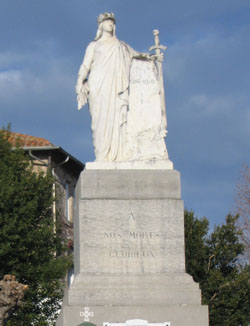
There, at a cross roads we spotted a war memorial to the Glorious Dead
of the 1914/18 war.
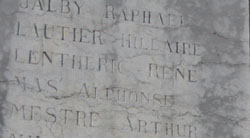
And there on the side was engraved the name of the man after whom our street; Rue Rene Lentheric, was named.
Not the founder of a fashion house but a young soldier who died in WW1.
Marmalade
January 10, 2007
11:15 AM
I just had a phone call from a reporter in the Irish Times this morning.
It seems that this reporter, one Michael Kelly, had decided to make up some Seville Orange Marmalade using one of my recipes.
I knew who it was immediately as I have been enjoying his pieces in the Saturday Times for months now.
He told me that the marmalade hadn’t set and he wanted me to tell him why.
My first question was:
“Did you use the Sureset Sugar it specified in the recipe?”
He hadn’t.
I then went into a lengthy dissertation about gelling points and sugar thermometers, (and the necessity of reading a recipe properly)
He was a patient man and took it all well and politely.
I , patronisingly, promised to email him my recipe for Fifteen Minute Marmalade which I told him was much easier to make.
It is amazing how often people ring me to abuse me about a recipe not working when they have changed it completely.
I always remember at a class I was giving in Kilkenny how a woman put up her hand and said that she had tried my recipe for Beef Bourguignon
And; “it didn’t work out the same at all as yours at all”
On further questioning it turned out that she had used chicken instead of beef, had left out the bacon (“John doesn’t like it”) and had used sherry in place of Burgundy.
I rest my case.
It will be interesting to see what Mr. Kelly’s piece about marmalade making turns out to be in the end.
Watch the Saturday Irish Times over the next few weeks.
In the meantime here are the two recipes;
Seville Orange Marmalade
1.5kg (3 lbs) Seville Oranges
3 litres Water
3 kgs. Sureset Sugar.
Put the whole Oranges into a large pot with the water and simmer together for about 90 mts.or until the skin is tender .
Take the oranges out of the water with a slotted spoon and cool, leave the water in the pot.
When they cool halve the oranges and remove the pips. Either discard these or put them in a little square of muslin tied at the edges to boil with the marmalade.
Now cut the halves of orange as finely or thickly as you like.
(If you don’t care too much about the appearance you can chop them up roughly in batches in a food processor)
Put these back into the orange water and add in the sureset sugar.
Bring gradually back to the boil (with the little bag of pips if you are using them) stirring to dissolve the sugar.Let it boil well for 5 mts. test for setting on a cool saucer.It should take no longer than 10 mts. boiling altogether.
Take out and discard the bag of pips, and pot in the usual way.
Fifteen Minute Marmalade.
2 Large Oranges
Water
1 kg Sureset Sugar.
Wash the oranges and remove the stem.
Halve them and remove the pips.
Put into a microwaveable bowl and cover with cling film.
Cook at full for 5 to 10 mts or more until the oranges are tender.
(Test very carefully with a skewer and replace the cling film afterwards)
Once cooked take them out of the microwave and leave to cool until you can handle them. Put all the orange (the pulp and skin and all )into a food processor along with any juice in the bowl and pulse until well chopped but not totally mushed.
Tip these into a pot with enough water to bring the mixture up to one litre.
Add 1 kilo of Sure Set sugar and bring to the boil.
Boil fast for 4 mts. (Time this carefully)
Have ready some sterilized jars and lids.
Pour the marmalade into the pots and cover when cool.
Variations:
Orange and Ginger Marmalade:
Add a peeled and grated thumb of root ginger to the orange puree as you put it on to boil. Then proceed as in the last recipe.
You could also add a tablespoon of crushed roasted coriander seeds at the same stage.
The Scots have been known to add a Tablespoon of Scotch Whisky just before potting, I reckon a similar dose of Irish Whiskey would work well.
Villages Circulades
January 9, 2007
14:06 PM
Thézan, is one of a group of villages called circulades, these are said to owe their origins to Roman times, as there is evidence of the circular shape being depicted in early manuscripts, but most were built between the 10th and 12th Centuries.
These villages are mainly found in Herault although there are a few in the Gard and Aude areas and they are often clustered around larger towns like Beziers in our case.
Although their history goes back so far their name, the circulade, was only invented in 1992.
It was a Polish urban architect called Pawlowski who noted these unique village structures at that time and coined the phrase.
Although they look similar on ground level to the Bastide village, common in the Lot and Dordogne, from the air their unique circular defensive structure is evident.
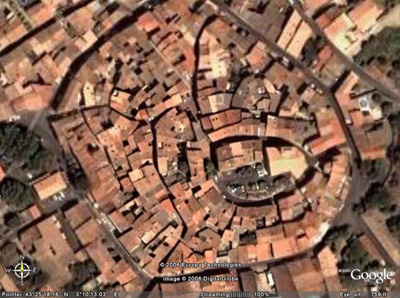
Thézan from Google Earth.
It was of course a defensive design.
The circle, having no corners is the easiest shape to defend
and the interior whorls of houses, usually circling the church
or, less usually the castle made it extremely difficult to capture.
The legacy of these defensive villages gives a whole structure of life which survives to today.
In Ireland the farmer usually built his farmhouse in the centre of his farm, and they lived, and still live rather lonely existences separated from each other from acres of fields.
The French farmer, more often a Vigneron, tended his vines and maybe built a hut to shelter in, some distance from the village but came back there at night for shelter, sleep and company.
From the obvious indications about my house in Thézan it was originally built as a Maison de Vignerons.
This is evident from the bootscrapers by the front door and even more obviously from my newly discovered Oxen stall by the back entrance.
This must have led to a much more social existence than the Irish one of distanced farms and is of course particularly relevant today.
On the radio this morning there is much talk of how the breathalyser is destroying Irish rural life.
The pub in Ireland is the only social centre for these disparate farmers and, with the advent of stricter drink driving laws, this meeting point is gradually disappearing.
I wonder if it is the ease which the French farmer can socialise on neutral ground, outside of the pub or café which leads to so much less drunkenness being evident in France than in Ireland?
|
